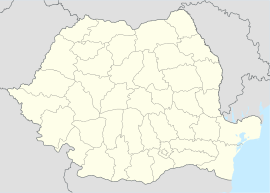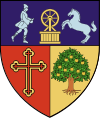world.wikisort.org - Romania
Drăgășani (Romanian pronunciation: [drəɡəˈʃanʲ] (![]() listen)) is a city in Vâlcea County, Romania, near the right bank of the Olt river, and on the railway between Caracal and Râmnicu Vâlcea. The city is well known for the vineyards on the neighboring hills that produce some of the best Wallachian wines.[3]
listen)) is a city in Vâlcea County, Romania, near the right bank of the Olt river, and on the railway between Caracal and Râmnicu Vâlcea. The city is well known for the vineyards on the neighboring hills that produce some of the best Wallachian wines.[3]
Drăgășani | |
|---|---|
Municipality | |
 | |
 Location in Vâlcea County | |
 Drăgășani Location in Romania | |
| Coordinates: 44°39′40″N 24°15′38″E | |
| Country | Romania |
| County | Vâlcea |
| Government | |
| • Mayor (2020–2024) | Cristian Nedelcu[1] (PSD) |
| Area | 44.57 km2 (17.21 sq mi) |
| Population (2011)[2] | 17,871 |
| • Density | 400/km2 (1,000/sq mi) |
| Time zone | EET/EEST (UTC+2/+3) |
| Vehicle reg. | VL |
| Website | www |
The city administers four villages: Capu Dealului, Valea Caselor, Zărneni and Zlătărei. It is situated in the historical region of Oltenia.
History
| Year | Pop. | ±% |
|---|---|---|
| 1900 | 4,398 | — |
| 1912 | 6,710 | +52.6% |
| 1930 | 7,002 | +4.4% |
| 1948 | 9,737 | +39.1% |
| 1956 | 9,963 | +2.3% |
| 1966 | 11,589 | +16.3% |
| 1977 | 15,647 | +35.0% |
| 1992 | 22,126 | +41.4% |
| 2002 | 22,499 | +1.7% |
| 2011 | 17,871 | −20.6% |
| Source: Census data | ||
Drăgășani stands on the site of the Daco-Roman Rusidava. On 19 June 1821, during the Greek War of Independence, the Ottomans routed the Filiki Eteria troops of Alexander Ypsilantis near the city in the Battle of Dragashani.[3] There Tudor Vladimirescu fought with his Panduri, revolutionary fighters consisting mainly of peasants and not armed with firepower, against the Turks.
Natives
- Florin Costea
- Mihai Costea
- Alexandru Dandea
- Mugur Isărescu
- Gib Mihăescu
- Adrian Păun
Notes
- "Results of the 2020 local elections". Central Electoral Bureau. Retrieved 9 June 2021.
- "Populaţia stabilă pe judeţe, municipii, oraşe şi localităti componenete la RPL_2011" (XLS). National Institute of Statistics.
- Chisholm, Hugh, ed. (1911). . Encyclopædia Britannica. Vol. 8 (11th ed.). Cambridge University Press. p. 465.
На других языках
- [en] Drăgășani
[ru] Дрэгэшани
Дрэгэшани (рум. Drăgășani) — город в Румынии, в жудеце Вылча. Расположен на правом берегу реки Олт. Железнодорожная станция на участке Каракал — Рымнику-Вылча. Известен как центр виноградарства. Второй по важности город жудеца Вылча.Другой контент может иметь иную лицензию. Перед использованием материалов сайта WikiSort.org внимательно изучите правила лицензирования конкретных элементов наполнения сайта.
WikiSort.org - проект по пересортировке и дополнению контента Википедии

